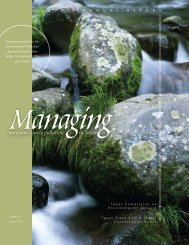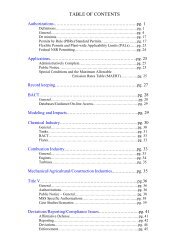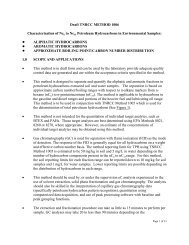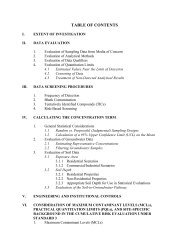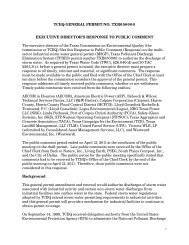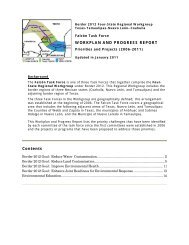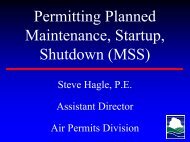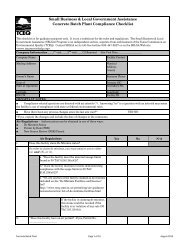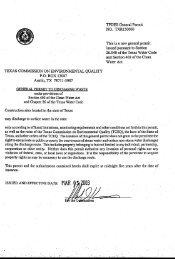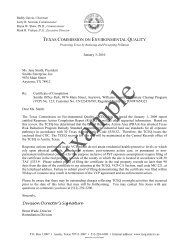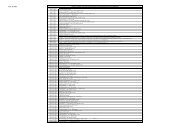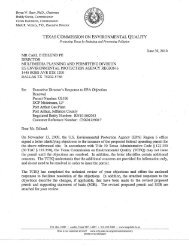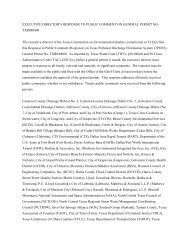Joint Groundwater Monitoring and ... - TCEQ e-Services
Joint Groundwater Monitoring and ... - TCEQ e-Services
Joint Groundwater Monitoring and ... - TCEQ e-Services
You also want an ePaper? Increase the reach of your titles
YUMPU automatically turns print PDFs into web optimized ePapers that Google loves.
10,000 mg/l <strong>and</strong> at a sustainable rate greater than 150 gallons per day<br />
to a well with a four inch diameter casing.<br />
<br />
A Class 3 groundwater resource includes any groundwater-bearing unit which<br />
produces water with a naturally occurring total dissolved solids content of greater<br />
than 10,000 mg/l or at a sustainable rate less than 150 gallons per day to a well<br />
with a four inch diameter casing.<br />
The st<strong>and</strong>ard groundwater response objectives do not apply typically to those<br />
stratigraphic units that do not contain enough groundwater to be considered a<br />
groundwater-bearing unit (that is, a non-groundwater bearing unit). The PCLs for<br />
COCs in Class 1 <strong>and</strong> 2 groundwater are determined as described above. The PCL for<br />
a COC in Class 3 groundwater is 100 times greater than the PCL for that COC in<br />
Class 1 or 2 groundwater. All of the groundwater with COC concentrations that<br />
exceed the applicable PCL are described as the protective concentration level<br />
exceedence (PCLE) zone. Lower cleanup levels than those based upon groundwater<br />
ingestion may be necessary to also be protective for cross-media exposure pathways<br />
such as groundwater-to-air <strong>and</strong> groundwater-to-surface water.<br />
The POE under TRRP is the location within an environmental medium where a<br />
receptor (human or ecological) will be assumed to have a reasonable potential to<br />
come into contact with COCs. For Class 1 <strong>and</strong> 2 groundwater resources, the<br />
prescribed POE to groundwater is a well which may be completed at all locations<br />
throughout the groundwater PCLE zone. For Class 3 groundwater, the prescribed<br />
POE to groundwater is set at all locations throughout the groundwater PCLE zone.<br />
Provided the person is authorized by the <strong>TCEQ</strong> to establish a plume management<br />
zone (PMZ) in Class 2 or 3 groundwater, the person may establish an alternate<br />
human health POE to groundwater. A PMZ is an exposure prevention approach. In<br />
other words, the person is not required to “cleanup” the contaminated groundwater,<br />
but is required to manage it <strong>and</strong> to indefinitely prevent its use. If a PMZ is approved,<br />
the person may move the POE from throughout the groundwater PCLE zone to the<br />
hydraulically downgradient limit of the PMZ. Alternate POEs <strong>and</strong> PMZs are<br />
discussed thoroughly in the <strong>TCEQ</strong> guidance document entitled Soil <strong>and</strong> <strong>Groundwater</strong><br />
Response Objectives (RG-366/TRRP-29).<br />
If PCLs are exceeded in the groundwater, a person may choose to conduct a response<br />
action so as to achieve the objectives of either Remedy St<strong>and</strong>ard A or Remedy<br />
St<strong>and</strong>ard B. Remedy St<strong>and</strong>ard A is a pollution cleanup remedy in that all PCLE<br />
zones in surface <strong>and</strong> subsurface soils, groundwater, <strong>and</strong> other environmental media<br />
must be removed <strong>and</strong>/or decontaminated to the extent that COC concentrations are<br />
less than the applicable PCLs. Physical controls are not allowed as a response action<br />
under Remedy St<strong>and</strong>ard A. In contrast, Remedy St<strong>and</strong>ard B, when appropriate,<br />
allows exposure prevention response actions (that is, use of physical controls). A<br />
response action under either of these remedy st<strong>and</strong>ards must be completed within a<br />
reasonable time frame.<br />
Under Remedy St<strong>and</strong>ard B, unless a person demonstrates that an affected property<br />
meets the qualifying criteria for a modified groundwater response approach, he must<br />
use either an active restoration approach or monitored natural attenuation to reduce<br />
the concentration of the COCs to the applicable PCLs throughout the groundwater<br />
PCLE zone within a reasonable time frame.<br />
21



